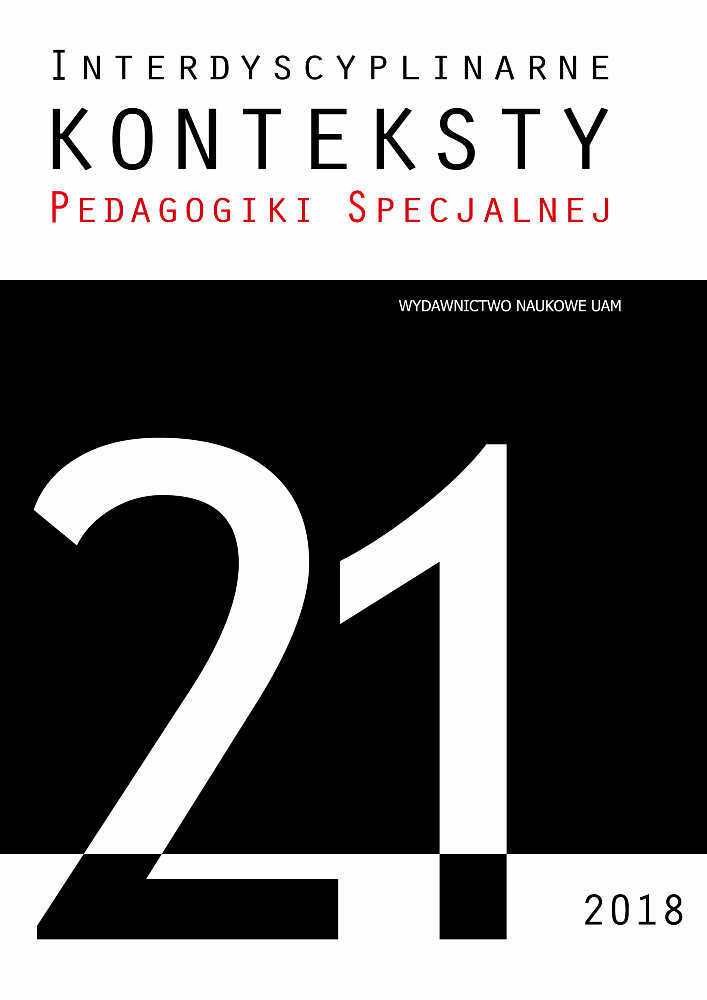Abstrakt
Early implantation and hearing and speech rehabilitation provide much wider opportunities to develop linguistic and communication skills for children with hearing impairment. The article presents own research, the aim of which was to determine the level of language competence of children with prelingual hearing deafness, which were implanted with a cochlear implant until the second year of life. The study involved a group of 169 children with prelingual hearing deafness. The tests used 6 Ling’s sounds, the MAIS scale, the MUSS scale and the TAPS test.
Bibliografia
Archbold S., Lutman M., Marschal D.: „ Categories of auditory performance”, Ann. Otol. Rhinol. Laryngol. 1995; 104 (suppl.166): 312-31410.
Archbold S., Lutman M.E.: „Categories of auditory performance: inner user reliability”, Br. J. Audiol. 1998; 32:7-12
Aronson L., Estienne P.: „Telephone speech comprehension in children with multichannel cochlear implants”, Am J Otol 1997; 18 (suppl): 151-152.
Broersen S., Cochleairr implantaat openet de wereld, Medisch Contact, 65, str, 528-531, 2010.
Demenko G., Rychter L., Pruszewicz A. i inn. „Testy do badania słuchowej percepcji mowy (TBPSM) dla dzieci z implantami ślimakowymi” Otolaryngologia Polska, 1996, T. L50.
Geremek A., Skarżyński H., Szuchnik J., Program implantów ślimakowych u dzieci – stan obecny, Audiofonologia Tom XIII, 1999.
Harrison R.V., Development of the Auditory System. From Periphery to Cortex, Comprehensive Handbook of Pediatric Audiology, 2011.
Krakowiak K., Propozycje zmian systemowych w zakresie kształcenia dzieci i młodzieży ze specjalnymi potrzebami edukacyjnymi spowodowanymi przez uszkodzenia słuchu (niesłyszących, słabosłyszących, niedosłyszących), „CZŁOWIEK – NIEPEŁNOSPRAWNOŚĆ – SPOŁECZEŃSTWO” nr 2(32) 2016, 49–66.
Kurkowski Z.M.: „Mowa dzieci sześcioletnich z uszkodzonym słuchem” UMCS Lublin 1996.
Leigh G., J.P. Newall, A.T. Newall, Newborn screening and earlier intervention with deaf children: Issues for developing world, [w:] M. Marschark, P. Spencer (red.), The Oxford Handbook of deaf studies, language and education, vol. 2, str. 345-359, 2010.
Lesinski A., Battmer R.D.: „Appropriate age for cochlear implantation in children: experenience since 1986 with 359 implanted children”,Adv. Otorhinolaryngol. 1997; 52: 214- 217.
Manrique M., Huarte A: „Indications and contrainications for cochlear implantation in children”, Am J Otol 1998; 332-336.
Mc Conkey Robbins A., Svirsky M.: „Children with implants can speak but can they communicate?”, Otolaryngol Head Nesk Surg 1997; 117: 155- 160
Mc Cornic B.: „ Audiometric evaluation of hearing loss in children”, Scand Audiol 1997; 26 (suppl. 46): 26-31
Miyamoto R.T., Kirk K.I.: „Communication skills in pediatric cochlear implant recipients”,Acta Otolarynol (Stockh) 1999; 219- 224
Miyamoto R.T., Kirk K.I.: Speechperception and speech production skills of children with multichannel cochlear implants”, Acta Otolaryngol (Stockh) 1996; 116: 240- 243
Ponton C.W., Eggermont J.J., Don M.: „Maturation of the mimatch negativity effects of profound children and cochlear implant use”, Audiol. Neurootol 2000; 5: 167-185
Porayski-Pomsta J., O rozwoju mowy dziecka. Dwa studia, Dom Wydawniczy Elipsa, Warszawa 2015.
Reid J., Bertram B. „Tests of Auditory Perception of Speech for Children” by Cochlear AG, Basel, Switzerland, August 1992
Robbins A. M., Osberger M. J.: „Meaningful Use of Speech Scale” Indiana Uniwersity School of Medicine, 1991
Robbins A. M.: „Developing meaningful auditory integration in children with cochlear implants” „Volta Review” 1990, 92, 361- 370
Ruben R.J., A Time Frame of Critical/Sensitive Periods of Language Development, IJO & HNS. Vol. 51 No. 3, July-September, str. 85-89, 1999
Smoczyński P., Przyswajanie przez dziecko podstaw systemu językowego, Zakład im. Ossolińskich, Wrocław 1955.
Snik A.F.M., Makhdoum M.J.A: „The relations between age at the time of cochlear implantation and long-term speech perception abilities in congenitally deaf subjects”, Int. J. Pediatr. Otorhinolaryngol 1997; 41:121- 131
Szagun G.: „The aquisition of grammatical and lexical structures in children with cochlear implants: a development psycholinquistic approach”, Audio Neurootol 2000: 5: 39-47
Szkiełkowska A. Skarżyński H., Piotrowska A., Lorens A., Szuchnik J., Postępowanie u dzieci ze wszczepami ślimakowymi, Otorynolaryngologia 2008, 7(3): 121-128
Szyfter W., Pruszewicz A., Szmeja Z., Szymiec E. i inn. „Poznański Program leczenia głuchoty dziecięcej metodą wszczepów ślimakowych” Otolaryngologia Polska 1997, Tom L, Suplement 22, 174- 178
https://whc.ifps.org.pl/2018/02/miedzynarodowy-dzien-implantu-slimakowego2/ (dostęp 20.04.2018)

